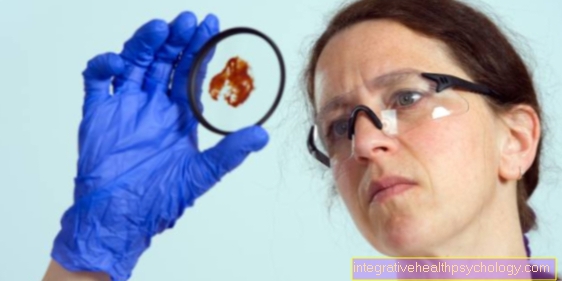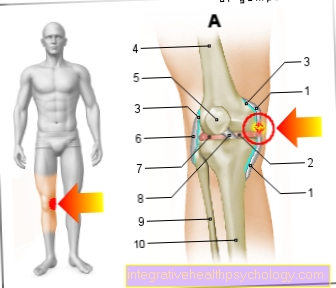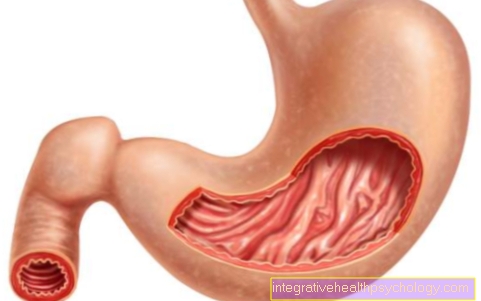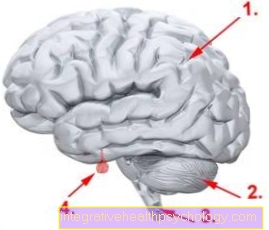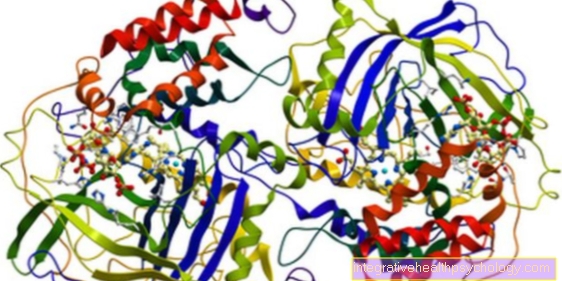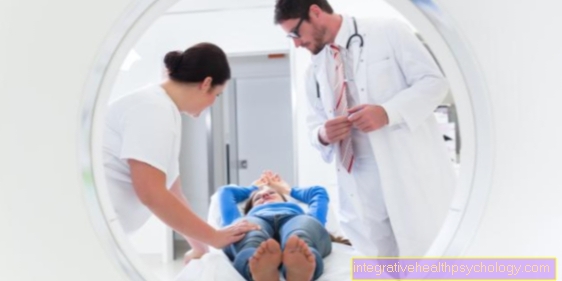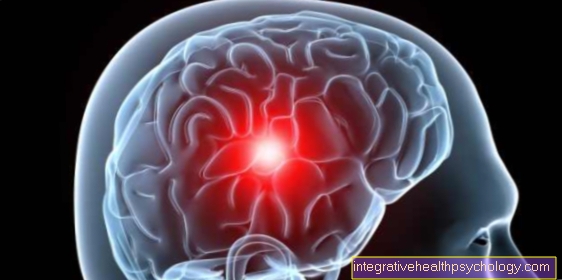Testicular cancer
Synonyms
Medical: Testicular cancer
English: orchid cancer
definition
Testicular cancer is the most common malignant Tumor disease of the young man between the ages of 20 and 40. Compared to other cancers, it has a share of 2% but rarely. Testicular cancer develops in 95% of the cases only in one of the two Testicles and can later also affect the vas deferens and the Epididymis pass over. In most cases, testicular cancer becomes symptomatic through a
- painless increase in size of the testicle, as well as by a
- Hardening of the tissue.

Despite its frequency, the prognosis of testicular cancer is in most cases very good as it increases 95% can be completely healed.
The testes are made up of different types of cells. Thus, different cell types can degenerate, which is why testicular cancer is divided into several subgroups.
There 90% of testicular tumors originate from the germ cells, which normally become the Sperm (Sperm cells) develop, germ cell tumors form the largest subgroup. Within these, the so-called seminomas are differentiated from the non-seminomas, which occur roughly equally. Non-seminomas can be tumors of various tissue types, such as
- Yolk sac tumors
- Chorionic carcinomas
- Embryonic cell carcinoma
- such as Teratomas.
The remaining 10% of testicular tumors are rare Leydig and Sertoli cell carcinomasthat come from the eponymous testosterone producing cells of the testicle emerge, as well as metastases (daughter tumors) of other organs.
It is very important to know the cellular origin of the tumor both for the treatment and for the prognosis of testicular cancer. This is done through a histological (tissue) examination after the surgical removal of the affected testicle. After the obligatory operation and subsequent adequate follow-up treatment such as radiation or chemotherapy, the patients have a very good chance of recovery. The loss of either testicle usually has no effect on the patient's potency or fertility.
Epidemiology
Testicular cancer occurs most often in medium- and Northern Europe, as in North America on. In Asia, Africa and South America, however, the diagnosis rarely appears. The annual incidence of testicular cancer is in Germany 9 per 100,000what approx. 4350 diagnoses per year corresponds. 200 men die from this disease every year. Within Europe, Germany has the highest incidence rate after Denmark;
Finland and Greece bring up the rear. The new disease rate in Germany increased by more than 50% between 1993 and 2004, while the age-standardized death rate decreased by 64%. The mean age of onset at Testicular cancer total is 36 years, divided into seminomics and non-seminomies, the maximum age is 37 and 27 years respectively. About 45% of those already infected are older than 40 years. Testicular cancer is associated with a high socioeconomic status, but there is also an urban - rural incidence gradient.
causes

A certain cause of testicular cancer is not yet known; however, there are several risk factors for developing testicular cancer. Men who have had a testicular tumor in the past have a 30 times higher risk than the normal population of developing testicular cancer again on the opposite side.
The relatives of testicular tumor patients form another risk group. For example, the brothers of those who are already ill have an 11-fold higher risk of developing testicular cancer than the normal population;Medical history).
The particularly high risk of the brothers of those affected suggests that in addition to a genetic predisposition, environmental influences that affect an individual within a generation also have a major influence on the cause of testicular cancer. In addition, there is also an increased incidence (new disease rate) of malignant testicular tumors in men who suffer from infertility. The same can be said of patients with testicular atrophy (Stunting) observe.
Some studies show that an increased level of estrogen in the mother during pregnancy has a negative influence on the embryonic development of the germ cells in the male fetus. Further indications of external influences were found in studies of farmers who showed increased exposure to fertilizers and who subsequently developed testicular cancer.
Cause undescended testicles
Furthermore, undescended testicles, which often occur in childhood, play the second largest role in the development of testicular cancer.
It increases the risk of developing a malignant tumor on the same side by 4 to 8 times, with 5-10% of men with Undescended testicles or an inguinal testicle also develop testicular cancer on the opposite side. The risk of degeneration is not reduced by the surgical correction that is often carried out in infancy.
Symptoms
70% of men with testicular cancer develop painless testicular enlargement. This is often accompanied by hardening of the testicular tissue. 10-20% of those affected, on the other hand, present themselves to the doctor with uncharacteristic pain in the testicles, which is usually caused by bleeding inside the tumor. Due to the hormone production of the tumor, which varies in quality and quantity, depending on the tissue origin, gynecomastia, i.e. an enlargement of the mammary glands in men caused by the influence of estrogen, may appear as a symptomatology. In advanced stages, back pain as a result of bone metastasis (spread of the tumor) or a dry cough with or without bloody sputum as a sign of lung metastases can exist.
Due to the low level of information available to young men about testicular cancer, as well as the high level of fear and inhibition before going to the doctor with complaints in this area, 50% of all testicular tumors are only detected 2 months after the onset of the symptoms, and thus in an advanced stage.
Read more about this under: Swollen testicles - what's behind it?
Summary
Testicular cancer is a rather rare cancer. However, it is the most common malignant disease in young men, with 95% of testicular tumors being germ cell tumors.
These are again divided into the groups of Seminomas and not seminomaswhich originate from different cell lines. The age peak is between both groups 30 and 40 years. Testicular cancer is mostly diagnosed by palpation and by one Ultrasound of the testicle diagnosed, with the final result only after the surgical exposure of the testicle and the tissue examination. After the testicle is removed, radiation therapy or radiation therapy is given, depending on the progression of the disease chemotherapy initiated. If the disease has only reached an early stage and has not yet formed metastases, these therapies can be dispensed with in many cases.
With such a wait-and-see therapy, however, it is very important to have the doctor closely monitor the further development in order to quickly start one of the two therapies mentioned above if the testicular cancer progresses. The prognosis for testicular cancer is different from most others Cancers very good.
With proper treatment, the chances of recovery in earlier stages are almost 100%, in more advanced still at 80%. It is therefore of great importance to consult a doctor as soon as possible if one or both testicles have increased in size in order to clarify the symptoms. Most men have no reason to fear that chemotherapy or the removal of a testicle could harm potency and fertility.
Even a single testicle still produces enough testosterone (male sex hormone) to induce an erection and be functional sperm to produce.





